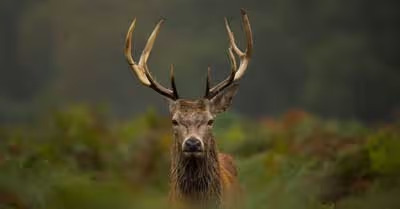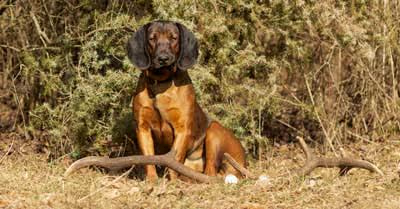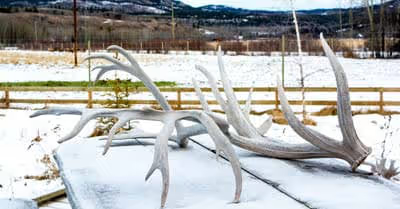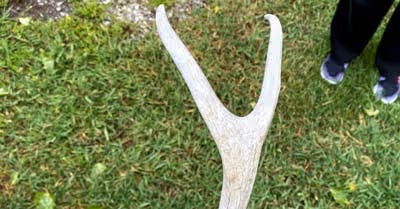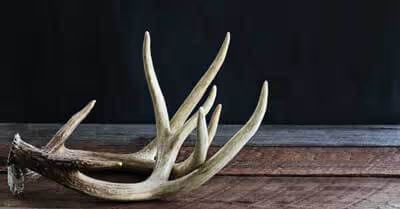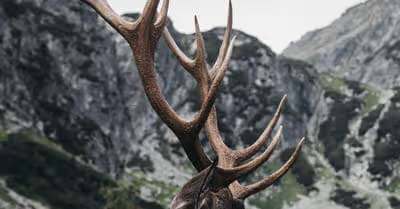Table of Contents
How to measure deer antlers for scoring purposes
First, your antlers should be very dry before you score them. Dry the antlers in the air for 60 days before you measure. An official scorer will not consider your antlers until they have dried for 60 days.
Your antlers have to be in good condition to be worthy of an official score. If the skull plate is damaged, you cannot officially score your antlers. An artificially repaired skull plate is not ok.
Your deer also has to have been killed fair and square according to the laws of your state. If it was not what your state would call a fair chase, your antlers have no official score.
Scoring a deer is not as complicated as it might seem to be at first. All you need is a flexible tape measure, a scoring sheet, and maybe also a yardstick for some measurements.
If you have a scoring sheet and what you need to measure the antlers, it should be easy to figure it out. You can find the scoring sheet on the Boone and Crockett club website or from a fish and wildlife department website.
Use a flexible measuring tape
The most useful tool for measuring deer antlers is a flexible measuring tape. You might also use a yardstick for some measurements, such as the tip to tip measurement, but a flexible measuring tape is necessary. An ordinary metal measuring tape is not flexible enough to measure the main beams' lengths or the antlers' circumference.
Measure the distance from tip to tip
Measure the distance from the tip of the left antler to the tip of the right. This is not the longest measurement, because the antlers come closer together towards the end.
Do the measurement from in front of rather than behind the antlers. Write your measurements down. It is easiest to follow the steps if you have a score sheet with you while you measure your rack.
Take a measurement for the greatest spread
The greatest spread is the distance from the farthest point of any part of the left antler to the farthest point on the right. You can take this measurement at any point on the antlers, so long as it is where the longest distance you can measure is. You can also do this measurement with a yardstick instead of with a flexible tape measure.
Measure the inside spread
Near the skull, the deer's antlers curve outward, and towards the end of the antlers, they curve back together again. In the middle, the antlers curve out the most.
Find the part where the main beams curve apart the most. Then, measure from one main beam to the other, at the points where you can measure the longest distance. This is the inside spread.
Measure the main beams
At this point, you will need a flexible cloth or steel measuring tape and not a yardstick. You can also use a steel cable to do the measurements. The right way to measure the main beam is to put the measuring tape along the center of the outside edge.
If you measure along the inside edge, you will end up with a different and inaccurate length. Measure from the base of the burr all the way to the tip. Always write down separate measurements for both the left and the right antler.
Measuring points
You have to take a lot of different measurements to complete scoring a pair of antlers. Now that you have finished the primary measurements, you have to measure the tines, which are the points that stick out of the antlers.
The G measurements
Start with the brow tine, which is the tine closest to the skull. Measure the length of the brow tine, and record this length as G1. Then, move on to the bay (the tine that is second nearest to the skull), measure its length, and mark that down as G2.
Then, measure the third and fourth tines and mark them down as G3 and G4. Repeat the process for the other antler.
The H measurements
Next, you should measure the circumference of the antlers. Wrap your measuring tape around the antlers to take these circumference measurements. There are four H measurements on each antler.
The first measurement is the H1 measurement. Find the area between the skull and the first of the four tines and measure the distance around it. Use the smallest part of the area between the skull and the first tine.
After the first measurement, measure the antler's circumference between the first tine and the second tine. This is your H2 measurement. Use the smallest part of the circumference here as well.
Measure between the second and third tine to get the H3 measurement. Between the third and fourth tines is the H4.
Sometimes, there is no fourth tine. In that case, measure the circumference halfway between the third tine and the end of the antler. Use the point between the third tine and the end as the H4 measurement.
Abnormal points reduce your score
You must differentiate between normal points and abnormal points. Abnormal points reduce your score, not increase it. Abnormal points that are less than an inch long are not counted and do not affect your score.
Adding up your points to find the total
To find your total score, you should first add all of your measurements up. Add up the length of the main beams and the length of the tines. Then, add the G measurements and the H measurements.
Once you have added everything up, you have your gross score, which is not your final score. You have to make deductions to find your net score. Add up the length of each abnormal point you have, and subtract the total from your net score.
Take points off for lack of symmetry
A great rack of antlers is symmetrical and not only huge, so you have to take points off wherever the rack is not symmetrical. Add up the differences between each measurement on the right antler and each measurement on the left.
For the G1 measurement, record the size of the difference between the G1 on the right antler and the G1 on the left. Do the same for the H1 measurement, the H3 measurement, and all other measurements.
Add up all of the differences there are. Then, subtract this from your score.
What you have left after adding everything up and subtracting points for abnormal tines and asymmetry is your net score, which is your final score. You are done at this point, and know how many points your rack scores. If you think you have a chance at the record books, talk to an official scorer.
What is an impressive score?
According to Boon and Crockett, 160 inches is impressive. If you do the math and end up with a length of over 160, you have a real trophy buck.
Different scoring systems have different standards.
What types of deer have the best racks?
An older buck will have much more massive and more impressive antlers than a younger deer. An older deer that lived a healthy life will have long, many pointed antlers with few flaws. A younger buck's antlers may have few points, so fewer points will be measured, and the score will be lower.
What is the highest score any hunter ever achieved?
In 2016, Steven Tucker shot a deer with a rack that measured 312 and 3/8 inches. You could do more than slightly better than that, although no one has yet broken his record.
A rack that measured 333 and 7/8 inches was found, but no hunter shot the deer. Someone will someday do more than a little better than the 312-inch record, as even better antlers are out there. Some pairs of deer antlers have dozens of points, so very high scores are possible.
Do younger bucks always have smaller antlers?
Older bucks usually have longer antlers, but there is no reliable way to tell a buck's age by its rack. The number of points does not directly correspond to the deer's age.
If a deer is in good health for its whole life, eating good food, it will grow more points than a buck that was poorly fed much of the time. Smaller antlers do not prove that a deer is very young.
Can you score antlers from a photograph?
Interestingly, modern technology allows you to score antlers with a cell phone app. Just take a picture and use the app to give you a score right away. If you shoot a trophy buck somewhere, return to that area - you might have similar success in that place again.
Recent Articles



